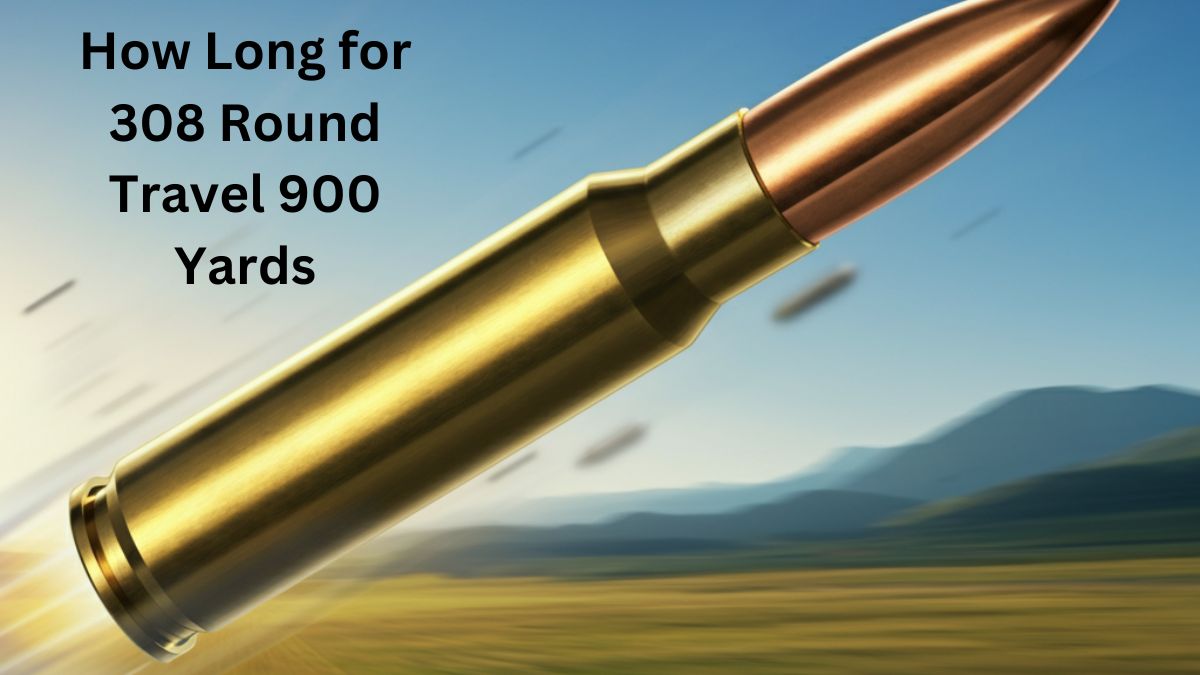When it comes to ballistics, understanding how ammunition behaves over different distances is critical, especially for precision shooters and hunters. One common question is how long it takes for a bullet, specifically a .308 round, to travel distances like 900 yards or more. While calculations depend on various factors—such as bullet speed, altitude, and environmental conditions—this post provides a detailed analysis based on average scenarios.
By the end of this guide, you’ll have precise answers to questions like how long a .308 round takes to travel certain distances, its energy at long ranges, comparisons with other calibers like the 6.5 Creedmoor, and more.
How Long Does It Take a Bullet to Travel 100 Yards?
The time it takes for a bullet to travel 100 yards depends on its initial velocity. A .308 Winchester round, one of the most popular calibers for long-distance shooting, typically travels at a muzzle velocity of around 2,800 feet per second (fps).
Calculations:
1 yard = 3 feet, so 100 yards = 300 feet.
Time = Distance ÷ Velocity = 300 ÷ 2800 ≈ 0.107 seconds.
This means a .308 bullet reaches 100 yards in roughly 0.1 seconds. Despite this short time, factors like air resistance slightly affect this calculation during real-world conditions.
How Long Does It Take a Bullet to Travel 150 Yards?
Using the same principles, let’s calculate the time for a .308 to cover 150 yards.
150 yards = 450 feet.
Time = 450 ÷ 2800 ≈ 0.16 seconds.
That’s nearly instantaneous, emphasizing how effective the .308 round is over short-to-medium distances.
How Long Does It Take a .308 Bullet to Travel 1,000 Yards?
At longer distances, a .308 bullet slows due to air resistance, meaning it will take significantly more time to travel 1,000 yards. The bullet’s speed at these ranges may drop to around 1,200 fps.
Step-by-Step Process:
- Convert 1,000 yards to feet (1,000 × 3 = 3,000 feet).
- Use the average velocity over this distance, considering deceleration. Here, we’ll approximate the average speed as 2,000 fps.
Time = 3000 ÷ 2000 = 1.5 seconds.
Thus, a .308 round typically takes 1.5 seconds to hit a target at 1,000 yards under standard conditions.
How Far Will a .308 Bullet Travel After Hitting a Deer?
When a .308 round strikes a deer or another medium-sized game, its energy dissipates rapidly. The distance the bullet travels after impact depends on:
- The bullet’s design (e.g., full metal jacket vs. soft point).
- The deer’s body composition (e.g., muscle, fat, bone).
- Impact velocity and angle.
On average, a hunting soft point .308 round will penetrate around 18–24 inches into a deer and fragment or stop due to energy transfer. It’s unlikely to travel far beyond the animal unless it completely exits the body at high speed.
.308 Energy at 1,000 Yards
Kinetic energy (KE) determines a bullet’s power upon impact. KE can be calculated using the formula:
KE = 0.5 × Mass × Velocity².
At 1,000 yards, a .308 bullet’s velocity reduces to approximately 1,200 fps, and its mass averages 150 grains (0.0214 pounds).
Using this formula:
KE = 0.5 × 0.0214 × (1200 × 1200) ≈ 15,408 ft-lbs.
This amount of energy is sufficient for long-range shooting, but its lethality for larger targets decreases significantly beyond this range.
How Far Will a .308 Shoot Flat?
A bullet’s flat shooting range refers to the distance it can travel without experiencing significant drop. For the .308:
- Zeroed at 100 yards, a .308 typically remains flat out to around 200–250 yards, assuming minimal wind interference.
- Beyond this range, gravity causes the bullet to drop significantly, requiring ballistic adjustments for accurate targeting.
With sufficient velocity and proper scope compensation, shooters can accurately hit targets beyond 500 yards.
6.5 Creedmoor vs. .308 at 1,000 Yards
The .308 and 6.5 Creedmoor are two favorites among long-range shooters. While both calibers are effective, they differ in ballistic performance beyond 1,000 yards.
.308 Winchester at 1,000 Yards:
- Velocity: ~1,200 fps.
- Bullet Drop: ~372 inches (31 feet).
- Wind Drift (10 mph crosswind): ~142 inches.
6.5 Creedmoor at 1,000 Yards:
- Velocity: ~1,460 fps.
- Bullet Drop: ~316 inches (26.3 feet).
- Wind Drift (10 mph crosswind): ~103 inches.
The 6.5 Creedmoor excels at long-distance shooting due to its higher velocity, reduced wind drift, and flatter trajectory. However, the .308’s versatility and availability make it a trusted option for many.
How Fast Is a .308 Bullet at 1,000 Yards?
Over extended distances, air resistance slows a .308 bullet considerably. Starting with a muzzle velocity of ~2,800 fps, its speed at 1,000 yards typically reduces to around 1,200 fps.
Different bullet weights and designs (e.g., match-grade vs. hunting rounds) can slightly alter this figure, but this average is a solid benchmark for shooters preparing for extreme distances.
Why Understanding .308 Ballistics Matters
Understanding the ballistics of a .308 round—its travel time, energy, and performance over various distances—is crucial for hunters, competitive shooters, and firearm enthusiasts. Whether you’re calculating bullet drop at long ranges or evaluating the energy required to ethically hunt game, ballistics play an essential role in making informed decisions.
Further Your Ballistics Knowledge
Want to learn more about precise shooting and ballistic calculations? Sign up for our weekly newsletter to access advanced tips, detailed charts, and exclusive long-range shooting guides.











